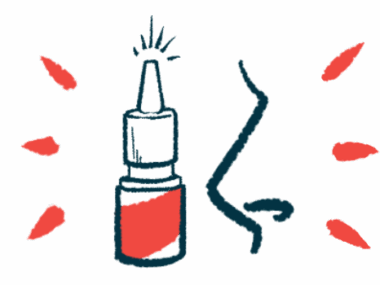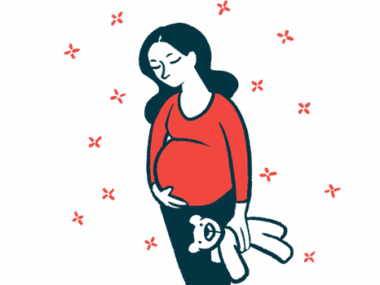Acute SCD-related pain events nearly double late in pregnancy
Single-center study used 6- to 9-month period after birth as a comparison
Written by |

Women with sickle cell disease (SCD) experience nearly double the rate of acute pain associated with the disease in the third trimester of pregnancy and in the first weeks following childbirth than in the 6- to 9-month period after childbirth.
That’s according to a single-center study from Ghana, which also found that in the period between the last trimester of pregnancy and the first six weeks following birth, the incidence rate of acute SCD pain at home was more than five times higher than that of acute SCD pain requiring hospitalization during pregnancy.
The study, “Prospective Cohort Study of eDiary Acute Pain Assessments in Sickle Cell Disease During Third Trimester and Postpartum” was published in Blood Advances.
Pregnant women with SCD have higher risk of complications
Pregnant women with SCD have a higher risk of experiencing SCD-related complications, namely acute pain associated with blood vessel blockage, particularly during the third trimester and the puerperium, or the first six weeks after childbirth. These acute pain events, also referred to as vaso-occlusive crises, are a leading cause of hospitalization during pregnancy, often preceding severe complications such as acute chest syndrome (ACS) and pulmonary thromboembolism.
“Despite the clinical impression that acute vaso-occlusive pain incidence rates in women with SCD are higher during pregnancy, few studies directly compare the incidence rate of acute vaso-occlusive pain in the home environment, where most acute SCD pain events are managed, to the incidence rate of acute vaso-occlusive pain that requires hospitalization,” the researchers wrote.
However, understanding the pain experienced by pregnant women with SCD is crucial, as high pain burdens can contribute to functional disabilities, psychosocial issues, and adverse fetal outcomes.
In this study, a team led by clinicians at a tertiary care hospital in Ghana used an eDiary mobile application to assess self-reported acute SCD pain during pregnancy and in the postpartum period. Specifically, they aimed to determine whether acute pain events in SCD during pregnancy — in the third trimester of pregnancy and puerperium — are more frequent than those reported after childbirth, specifically 6 to 9 months following delivery.
They also assessed whether self-reported pain events during pregnancy exceeded those that required hospitalization during the same timeframe.
Pain due to SCD was rated by participants on a scale from 0 to 10, with higher numbers indicating increased pain.
All women reported at least one SCD pain event during pregnancy
A total of 40 pregnant women with SCD agreed to participate in the study, with 33 (82.5%) using the eDiary mobile application throughout the study period. Those who consistently used the app throughout the study had a median age of 31 years and were followed for a median of 231 days, or about 7.6 months. They had a median gestational age of 12.7 weeks at the time of enrollment.
Women self-reported acute pain on 8.3% of the days they used the eDiary, totaling 143 distinct acute SCD pain events. More than half of these (68.5%) occurred during pregnancy, with 31.5% happening in the postpartum period.
All women reported at least one SCD pain event during pregnancy, while 75.8% did so during the postpartum period. The average self-reported acute SCD pain intensity was significantly higher during pregnancy compared with the period following childbirth (3.9 vs. 3.3). There was also a higher incidence rate of acute SCD pain during pregnancy than in the postpartum period (0.74 vs. 0.40 events per person-month).
Our results indicate that counseling for women with SCD should address the expected increase in acute vaso-occlusive pain events during pregnancy (both at home and requiring hospitalization), especially in the 3rd trimester and puerperium.
Hospitalization for acute SCD pain significantly increased during pregnancy, with 42.4% of women being hospitalized at least once compared with 6.1% after pregnancy. The median duration of hospitalization was also longer during pregnancy compared with the postpartum period (mean of 7 days vs. 1.5 days). The incidence rate of acute SCD pain requiring hospitalization was higher during pregnancy than after pregnancy (0.14 vs. 0.02 events per person-month).
Adherence to the eDiary mobile application was generally high, averaging 65.5% during pregnancy and 78.6% after pregnancy.
Two women were hospitalized for ACS during the third trimester of pregnancy, but no such cases occurred after pregnancy. A small percentage of participants received simple blood transfusions for symptomatic anemia during pregnancy.
“Our results indicate that counseling for women with SCD should address the expected increase in acute vaso-occlusive pain events during pregnancy (both at home and requiring hospitalization), especially in the 3rd trimester and puerperium. With appropriate regulatory oversight, further studies need to focus on the management of acute SCD pain at home and during hospitalizations,” the researchers wrote.







